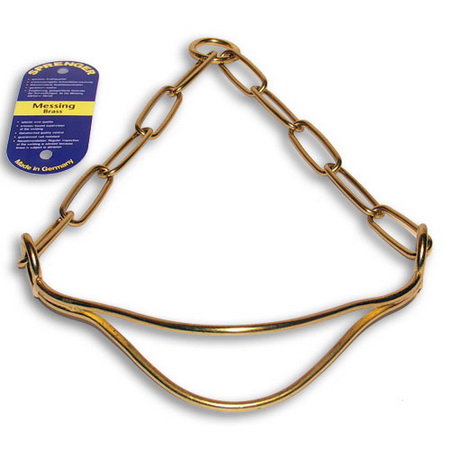Liesje
Posted : 1/5/2010 9:06:18 AM
When I am showing my dog (UKC and formerly AKC), I move the collar around depending on what I'm doing. When moving the dog around the ring, I generally like it lower on the neck and not restricting. I want the dog to pull out and look natural; I don't want him to look like I am the one holding his head up. If he's not moving well, then that tells me we need more ring training and practice. With a male German Shepherd that is easily stronger than I am, there's not a lot I can do to really control his movement in the ring, for us the gaiting is all training.
In the UKC, I use either a black rolled leather martingale (gold chain) with a matching thin black leather lead with a gold snap, or a thinner nylon collar/lead combo that goes over the dog's head and then has a slider for the collar. It's not a choke; it does not tighten if you pull, in fact, the slider starts moving up and the collar gets loose.


I also have a thin black leather slip collar which I often use in training but on the DEAD ring. I don't show the dog in it typically because on the dead ring, it's a little big yet.

When I am stacking the dog for the judge, I move the collar up under the chin so that it's easier for me to hold and not have it sliding all over the place. I generally step/walk my dog into a stack for the front and then adjust the rear legs if needed.


Now for the SV ring, everyone uses the collars below. The first is the "puppy" collar, basically a Fursaver with a leather pad. The second is the standard Fursaver. The third is a more expensive Herm Sprenger show collar that fits on the neck. While being shown the dog is always on a DEAD ring. Even though a Fursaver is a "choke chain", that is NOT how it is used in the SV ring. Also, a dog typically wears a Fursaver many sizes larger than what they'd need to use as a regular choke collar. Nikon wears a 21" Fursaver for tracking (also on a dead ring), but he wears a 27" Fursaver in the show ring. Even for a 3 month old puppy, the 18" Fursaver I have is considered too small. It needs to sit low and loose on the dog's neck so he can pull into it without being choked off. Again, if the dog cannot be controlled without choking and being strung up, then he needs more training, not a choke collar!
Puppy collar

Fursaver

How a Fursaver is worn - large and loose so the lead basically attaches at the wither. First a puppy, then a young dog, then an adult...



Show collar (notice that you cannot use this as a choke collar even if you wanted to)

You can't see the front, but this dog is wearing the show collar

The adult dogs have to gait off lead, so yeah, it's really all about training!

